
Some economists and investors are warning about the threat of rising inflation even with the U.S. still struggling to recover from deepest recession ever. What’s behind these seemingly sudden inflationary fears and and how big is the threat? MarketWatch explains.
Why all this inflation talk?
Washington has already approved about $3 trillion in financial aid for families, unemployed workers and struggling businesses since the onset of the pandemic last spring. Now the Biden administration is seeking another $1.9 trillion.
These are astonishingly huge sums. All that extra money sloshing around along with record low interest rates, the thinking goes, has already pushed stocks to record highs. It could also trigger a massive boom in pentup consumer spending if the coronavirus vaccines are effective and the U.S. economy makes a full recovery.
Businesses in turn would respond to the surge in demand by raising prices.
Ergo, higher inflation.
What is the worry?
Inflation erodes the value of money. Families fall behind when prices rise faster than their paychecks. Higher prices also drive up interest rates and favors bonds over stocks.
The worst-case scenario envisions an unexpectedly large increase in inflation by early next year topping well over 3% that forces the Federal Reserve to raise interest rates sooner and more aggressively than expected.
The results could be devastating. Higher inflation and interest rates could send stocks DJIA, +0.35% plummeting, choke off growth in a still-healing economy and potentially even induce another recession.
The Biden stimulus could “set off inflationary pressures of a kind we have not seen in a generation,” wrote former Democratic Treasury Secretary Lawrence Summers in a widely read article in the Washington Post.
How likely are higher prices?
Very. Inflation is on the rise again and is certain to move higher in the next year.
Read: Wholesale inflation posts biggest surge since 2009, PPI shows
How come? The cost of many goods and services fell early in the pandemic amid a brief collapse in demand and they are slowly returning to precrisis levels. And prices for some key raw materials such as lumber and soy beans have already gone through the roof.
The consumer price index, the main tool for measuring changes in the cost of living, rose in January at a 12-month pace of 1.4%. It had tumbled to a yearly rate of almost zero last May from a 2.3% clip just before the crisis started.
Even the pre-pandemic level of inflation overstates the problem, however. Inflation has generally been quite tame over the past decade and mostly fallen short of the 2% target the Fed thinks is optimal for the U.S. economy.
“We believe that underlying trends will remain locked close to 2% when the dust settles,” wrote chief economist Douglas Porter of BMO Capital Markets.
How much inflation will the Fed tolerate?
A lot. Fed Chairman Jerome Powell is prepared for burst of inflation once the economy is mostly healed, but he argued in a speech last week that any increase is likely to be mild and temporary.
“That’s really not going to mean very much,” he said.
The Fed laid the groundwork for a more relaxed approach last year when it adopted a new strategy of “inflation averaging.” If inflation runs at, say, 1% for a while, the Fed would be willing to let it go to 3% for a similar period.
“The Fed will have no problem with inflation being 2.5% to 3% a for a few years. Not at all,” said Joel Naroff of Naroff Economic Advisors.
What the most realistic outcome?
The Fed’s main worry is not higher inflation, it’s the damage done to the labor market by the pandemic. Many jobs could end up lost for good and it could take several years for unemployment to fall close to the pre-pandemic level of 3.5%.
“You still have 10 million unemployed,” said chief U.S. economist Steve Blitz of TS Lombard.
Yet if the rate of inflation exceeds a yearly pace of 3% by late 2021 or 2022, as seems quite possible, the Fed would be put on the spot. The central bank would likely raise interest rates, if just to appease the angst of investors, but Powell has repeated stressed the Fed will move slowly and not panic.
“Inflation has been much lower and more stable over the past three decades than in earlier times,” Powell said last week.
Is Powell’s history correct?
Yes, it is. The U.S. — and the rest of the world — is in the midst of a long period of low and relatively stable inflation. Consumer prices have risen an average of just 2.1% since the turn of the century.
The last time the U.S. had a truly bad bout of sustained price increases was more than 40 years ago. Inflation soared during the 1970s owing to the end of the Bretton Woods global financial-exchange system, several oil shocks and a brief period of price controls.
Annual inflation peaked at 13.5% in 1980.
What’s so different now?
Everything.
Back in the 1970s the U.S. economy was more insulated from the rest of the world except for its dependency on foreign oil. Most goods that consumers purchased were made in America by unionized American workers who earned high wages.
The oil shocks and related wage spirals in the 1970s produced the biggest prolonged bout of high inflation in American history.
Fast forward to today. Oil is a much smaller part of the economy, union membership is at near all-time low, and the U.S. has become more integrated into a large global economy in which competition is as fierce as ever.
Companies can relocate operations anywhere in the world to take advantage of lower production costs or cheaper labor in countries like China, Vietnam, Mexico or India. That’s kept a tight check on prices.
Consumers, for their part, can log on to the Internet, find the cheapest prices and order from all over in the world. No longer are the beholden to local merchants charging monopoly-like prices.
High inflation is all but certain to return someday, but all the trends that were keeping inflation low before the pandemic will still be in place after it ends.











Add Comment